1998 PONTIAC GRAND PRIX warning
[x] Cancel search: warningPage 202 of 402
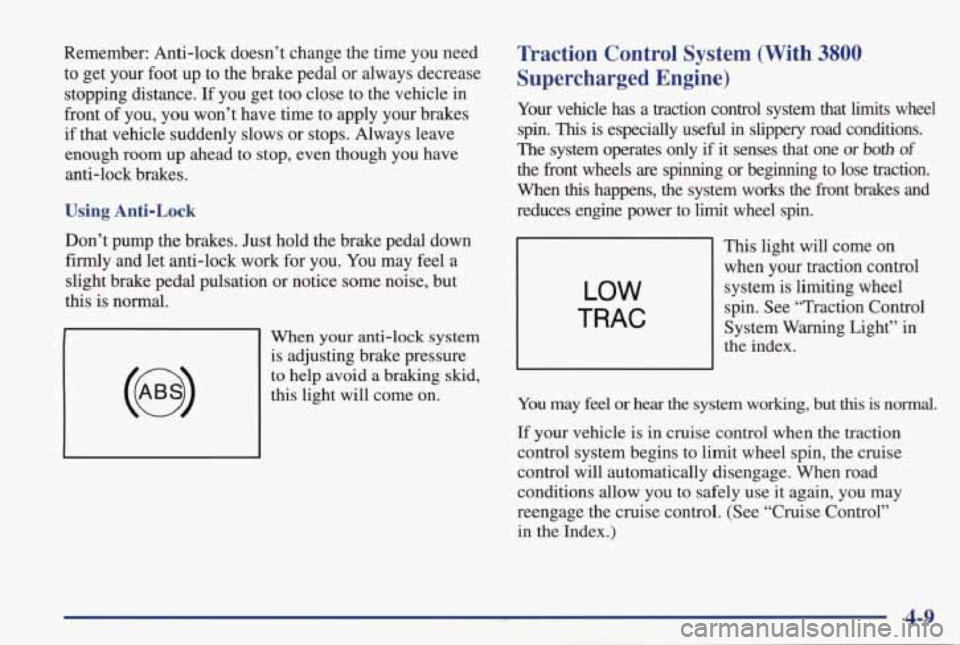
Remember: Anti-lock doesn’t change the time you need
to get your foot up to the brake pedal or always decrease
stopping distance. If you get too close to the vehicle
in
front of you, you won’t have time to apply your brakes
if that vehicle suddenly slows or stops. Always leave
enough room up ahead to
stop, even though you have
anti-lock brakes.
Using Anti-Lock
Don’t pump the brakes. Just hold the brake pedal down
firmly and let anti-lock work for you. You may feel a
slight brake pedal pulsation or notice some noise, but
this is normal.
When your anti-lock system
is adjusting brake pressure
to help avoid a braking skid,
this light will come on.
Traction Control System (With 3800
Supercharged Engine)
Your vehicle has a traction control system that limits wheel
spin.
This is especially useful in slippery road conditions.
The system operates only if it senses that one or both of
the front wheels are spinning or beginning to lose traction.
When
this happens, the system works the front brakes and
reduces engine power to limit wheel spin.
LOW
TRAC
This light will come on
when your traction control system is limiting wheel
spin. See “Traction Control
System Warning Light” in
the index.
You may
feel or hear the system working, but this is normal.
If your vehicle is in cruise control when the traction
control system begins to limit wheel spin,
the cruise
control will automatically disengage. When road
conditions allow you to safely use it again, you may
reengage the cruise control. (See “Cruise Control” in the Index.)
Page 203 of 402
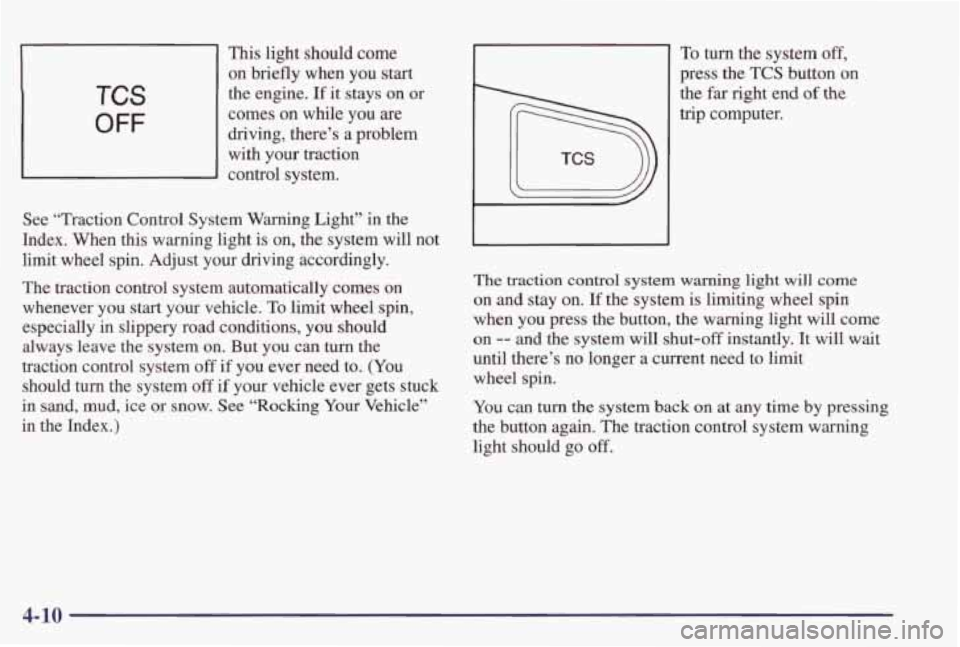
This light should come on briefly when you start
comes on while
you are
driving, there’s a problem with your traction
control system.
TCS
OFF
the engine. If it stays on or
See “Traction Control System Warning Light” in the
Index. When this warning light is on, the system will not
limit wheel spin. Adjust your driving accordingly.
The traction control system automatically comes on
whenever you start your vehicle.
To limit wheel spin,
especially in slippery road conditions, you should
always leave the system on. But you can
turn the
traction control system
off if you ever need to. (You
should
turn the system off if your vehicle ever gets stuck
in sand, mud, ice or snow. See “Rocking Your Vehicle”
in the Index.)
To turn the system off,
press the TCS button on
the far right end of the
trip computer.
The traction control system warning light will come
on and stay on. If the system is limiting wheel spin
when you press the button, the warning light will come
on -- and the system will shut-off instantly. It will wait
until there’s no longer
a current need to limit
wheel spin.
You can
turn the system back on at any time by pressing
the button again. The traction control system warning
light should go
off.
4-10
Page 204 of 402
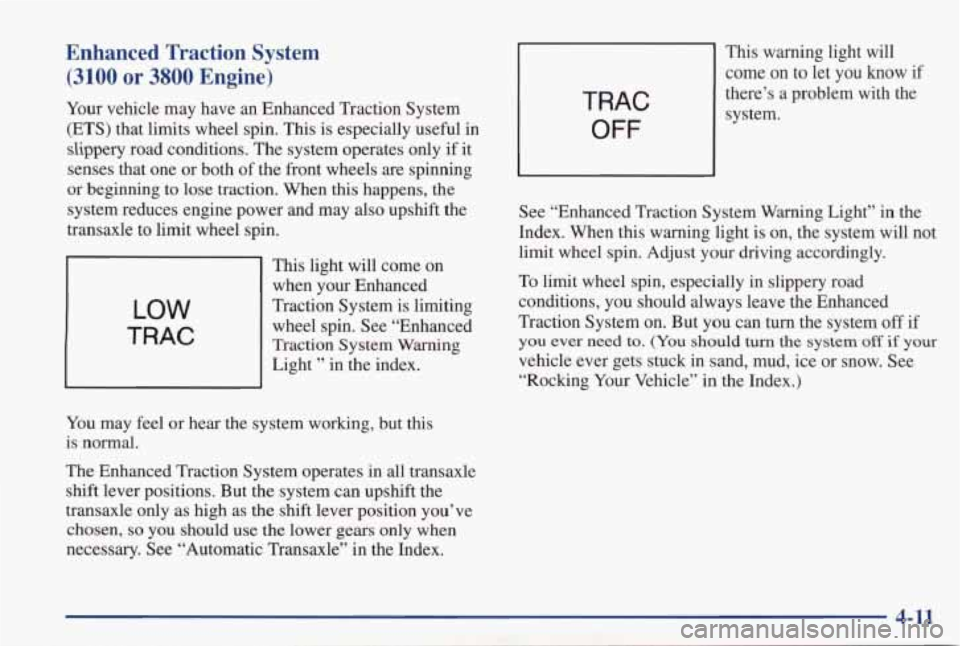
Enhanced Traction System
(3100 or 3800 Engine)
Your vehicle may have an Enhanced Traction System (ETS) that limits wheel spin. This is especially useful
in
slippery road conditions. The system operates only if it
senses that one or both of the front wheels
are spinning
or beginning to lose traction. When
this happens, the
system reduces engine power and may
also upshift the
transaxle
to limit wheel spin.
LOW
TRAC
This light will come on when your Enhanced
Traction System is limiting wheel spin. See “Enhanced
Traction
System Warning
Light
” in the index.
You may feel or hear the system working, but this
is normal.
The Enhanced Traction System operates in all transaxle
shift lever positions. But the system can upshift the
transaxle
only as high as the shift lever position you’ve
chosen,
so you should use the lower gears only when
necessary. See “Automatic Transaxle” in
the Index.
1
This warning light will
come
on to let you know if
there’s a problem with the TRAC
OFF
system.
See “Enhanced Traction System Warning Light” in the
Index. When this warning light is on, the system will not
limit wheel spin. Adjust your driving accordingly.
To limit wheel spin, especially in slippery road
conditions, you should always leave the Enhanced
Traction System on. But you can
turn the system off if
you ever need to. (You should turn the system off if your
vehicle ever gets stuck in sand, mud, ice or snow. See
“Rocking Your Vehicle” in the Index.)
Page 205 of 402
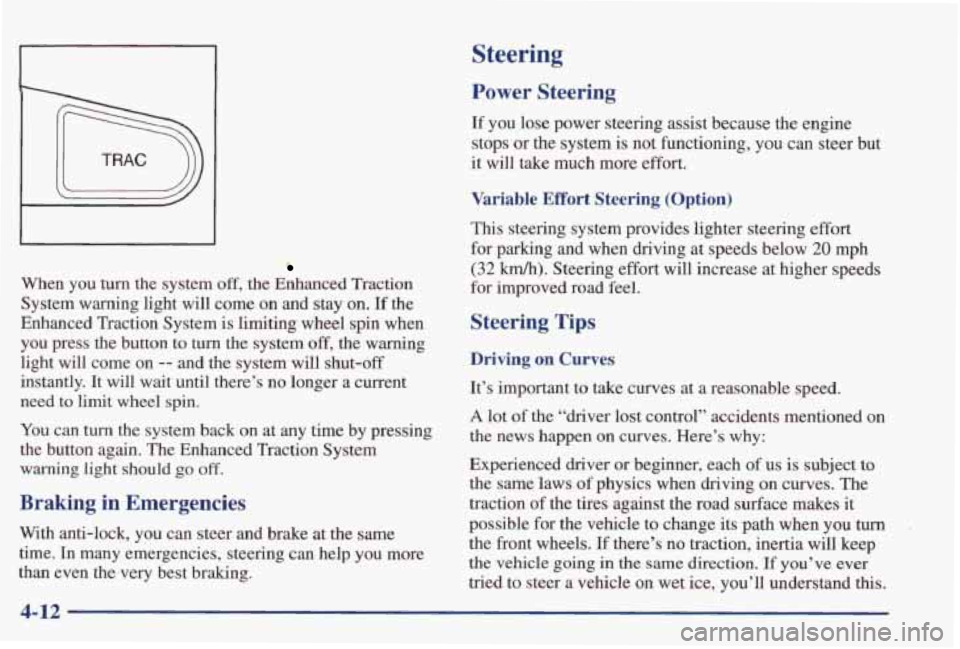
When you turn the system off, the Enhanced Traction
System warning light
will come on and stay on. If the
Enhanced Traction System is limiting wheel spin when
you press the button to turn the system off, the warning
light will come on
-- and the system will shut-off
instantly. It will
wait until there’s no longer a current
need
to limit wheel spin.
You can
turn the system back on at any time by pressing
the button again. The Enhanced Traction System
warning light should go off.
Braking in Emergencies
With anti-lock, you can steer and brake at the same
time.
In many emergencies, steering can help you more
than even the very best braking.
Steering
Power Steering
If you lose power steering assist because the engine
stops or the system
is not functioning, you can steer but
it will take much more effort.
Variable Effort Steering (Option)
This steering system provides lighter steering effort
for parking and when driving at speeds below
20 mph
(32 km/h). Steering effort will increase at higher speeds
for improved road feel.
Steering Tips
Driving on Curves
It’s important to take curves at a reasonable speed.
A lot of the “driver lost control” accidents mentioned on
the
news happen on curves. Here’s why:
Experienced driver or beginner, each
of us is subject to
the same laws
of physics when driving on curves. The
traction
of the tires against the road surface makes it
possible for the vehicle to change its path when you
turn
the front wheels. If there’s no traction, inertia will keep
the vehicle going
in the same direction. If you’ve ever
tried
to steer a vehicle on wet ice, you’ll understand this.
4-12
Page 210 of 402
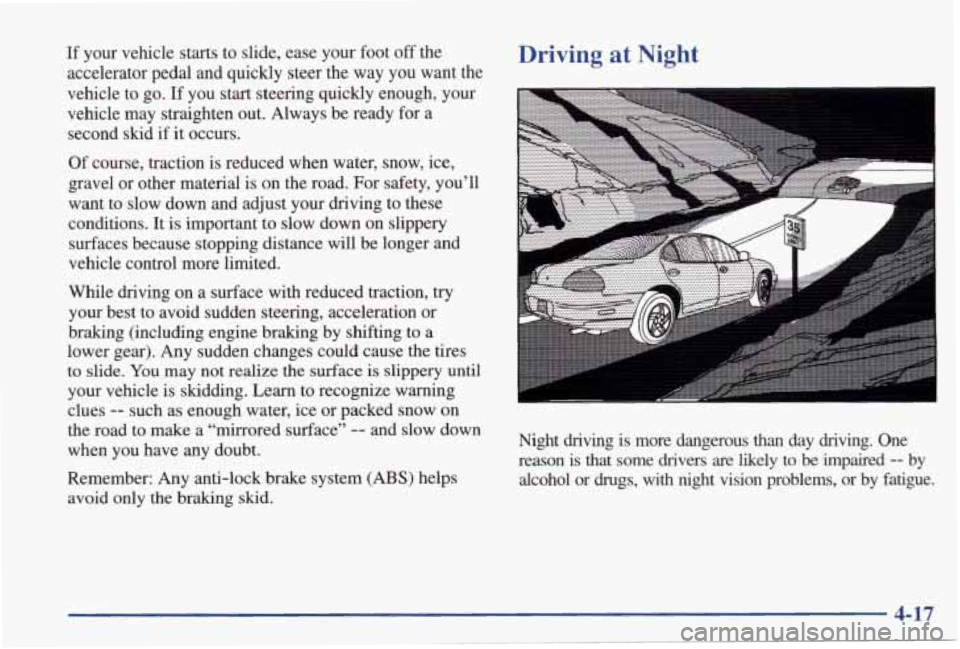
If your vehicle starts to slide, ease your foot off the
accelerator pedal and quickly steer the way you want the
vehicle to go.
If you start steering quickly enough, your
vehicle may straighten out. Always be ready for a
second skid
if it occurs.
Of course, traction is reduced when water, snow, ice,
gravel or other material is on the road. For safety, you’ll
want to slow down and adjust your driving to these
conditions. It
is important to slow down on slippery
surfaces because stopping distance will be longer and
vehicle control more limited.
While driving
on a surface with reduced traction, try
your best to avoid sudden steering, acceleration or
braking (including engine braking by shifting to a
lower gear). Any sudden changes could cause the tires
to slide. You may not realize the surface is slippery until
your vehicle is skidding. Learn to recognize warning
clues
-- such as enough water, ice or packed snow on
the road to make a “mirrored surface” -- and slow down
when you have any doubt.
Remember: Any anti-lock brake system
(ABS) helps
avoid only the braking
skid.
Driving at Night
Night driving is more dangerous than day driving. One
reason is that some drivers
are likely to be impaired -- by
alcohol or drugs, with night vision problems, or by fatigue.
4-17
Page 215 of 402
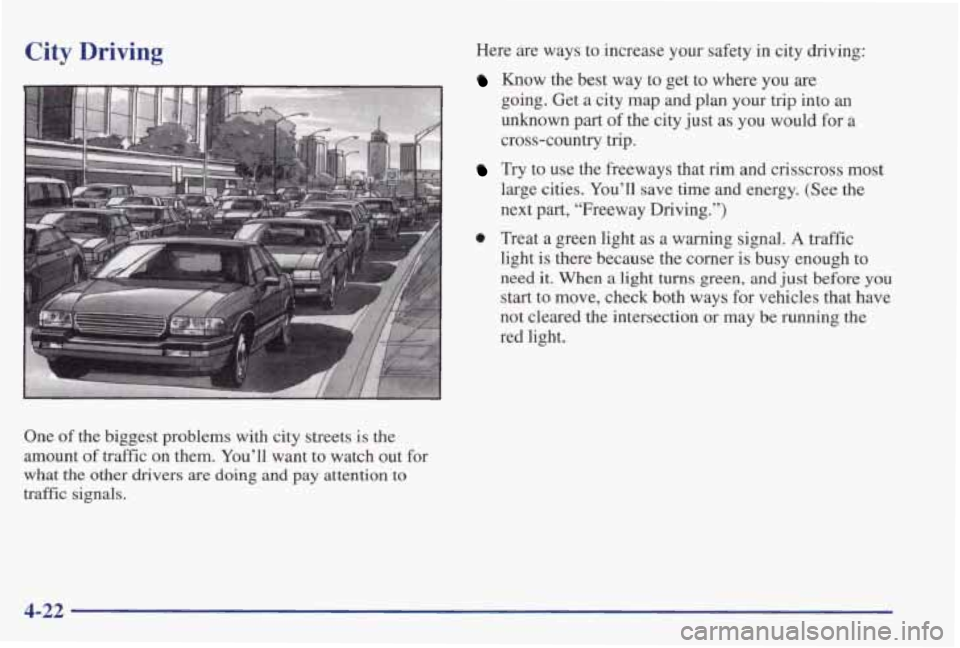
City Driving
I
One of the biggest problems with city streets is the
amount
of traffic on them. You’ll want to watch out for
what
the other drivers are doing and pay attention to
trafk signals. Here are ways to increase your safety
in city driving:
Know the best way to get to where you are
going. Get a city map and plan your trip into an
unknown part of the city just as you would for a
cross-country trip.
Try to use the freeways that rim and crisscross most
large cities. You’ll save time and energy. (See the
next
part, “Freeway Driving.”)
0 Treat a green light as a warning signal. A traffic
light is there because the corner is busy enough to
need it.
When a light turns green, and just before you
start to move, check both ways for vehicles that have
not cleared the intersection or may be running the
red light.
4-22
Page 220 of 402
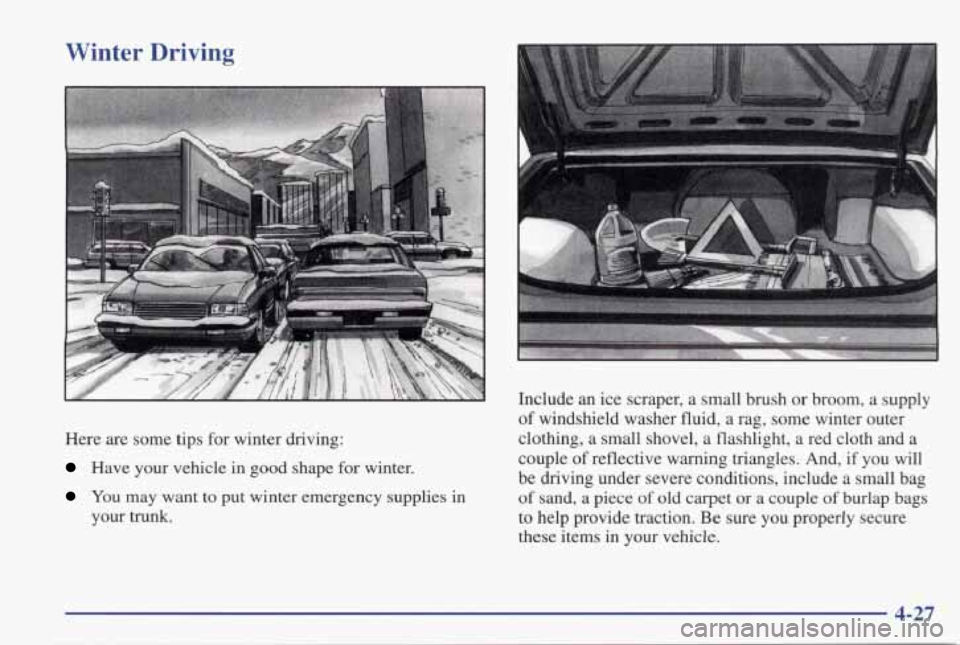
Winter Driving
Here are some tips for winter driving:
Have your vehicle in good shape for winter.
You may want to put winter emergency supplies in
your trunk. Include an
ice scraper, a small brush
or broom, a supply
of windshield washer fluid, a rag, some winter outer
clothing, a small shovel, a flashlight, a red cloth and a
couple of reflective warning triangles. And, if you will
be driving under severe conditions, include a small bag
of sand, a piece of old carpet or a couple of burlap bags
to help provide traction.
Be sure you properly secure
these items in your vehicle.
4-27
Page 231 of 402

Making lhms
NOTICE:
Making very sharp turns while trailering could
cause the trailer to come in contact with the
vehicle. Your vehicle could be damaged. Avoid
making very sharp turns while trailering.
When you’re turning with a trailer, make wider turns
than normal.
Do this so your trailer won’t strike soft
shoulders, curbs, road signs, trees or other objects.
Avoid jerky
or sudden maneuvers. Signal well
in advance.
Thrn Signals When Towing a Trailer
When you tow a trailer, your vehicle may need a
different
turn signal flasher and/or extra wiring. Check
with your Pontiac dealer. The green arrows on your
instrument panel will flash whenever you signal a turn
or lane change. Properly hooked
up, the trailer lamps
will
also flash, telling other drivers you’re about to turn,
change lanes or stop.
When towing a trailer, the green mows on your
instrument panel will flash for turns
even if the bulbs on
the trailer are burned out. Thus, you may think drivers
behind you are seeing your signal when
they are not. It’s
important to check occasionally to be sure the trailer
bulbs are still working.
Your vehicle has bulb warning lights. When you plug a
trailer lighting system into
your vehicle’s lighting
system, its bulb warning lights may not let you
know if
one of your lamps goes out.
So, when you have a trailer
lighting system plugged in, be sure to check your
vehicle and trailer lamps from time to time to be sure
they’re
all working. Once you disconnect the trailer
lamps, the bulb warning lights again can tell you if one
of your vehicle lamps is out.
4-38